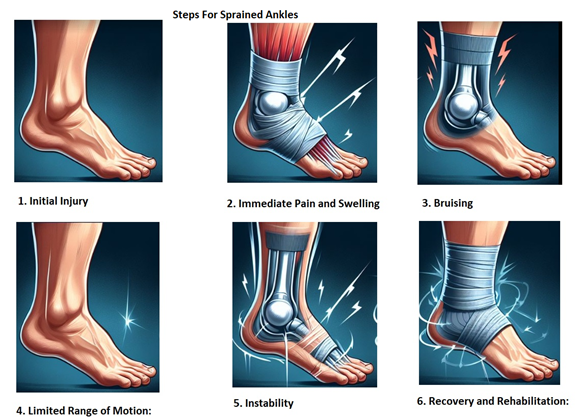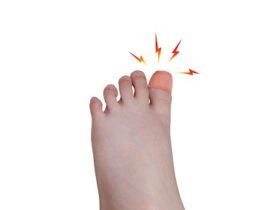A sprained ankle is a common injury that can occur during physical activities or even simple movements, leading to pain, swelling, and difficulty walking. For those grappling with this injury, a pressing question often arises: How long does it take for a sprained ankle to heal? While the typical healing time varies depending on the severity of the sprain, it generally ranges from a few weeks to several months. However, several factors, such as the extent of the injury, the individual’s healing capacity, and adherence to proper treatment and rehabilitation, can significantly impact the healing process. Understanding these factors is essential for effectively managing a sprained ankle and promoting a successful recovery. We will explore these details further at the end of this article to provide comprehensive insights into the healing process of sprained ankles.
What is a Sprained Ankle?
A sprained ankle occurs when the ligaments surrounding the ankle joint are stretched or torn, typically as a result of sudden twisting or rolling of the foot. Ligaments are tough bands of tissue that connect bones to one another and provide stability to the joint. When subjected to excessive force or pressure, such as during a sudden change in direction or a landing on an uneven surface, the ligaments can become overstretched or even torn. This leads to pain, swelling, and instability in the ankle joint, making it difficult to bear weight or engage in normal activities. Sprained ankles are graded based on the severity of the injury, ranging from mild stretching of the ligaments to complete tears. Proper diagnosis and treatment are crucial for managing a sprained ankle and preventing long-term complications.
Different Types of Sprained Ankle
Ankle sprains can vary in severity and the specific ligaments involved, leading to different types of sprains. The three primary types of ankle sprains are:
- Inversion Sprain: This is the most common type of ankle sprain and occurs when the foot rolls inward, causing the outer ligaments of the ankle to stretch or tear. Inversion sprains typically affect the lateral ligaments, including the anterior talofibular ligament (ATFL), calcaneofibular ligament (CFL), and posterior talofibular ligament (PTFL).
- Eversion Sprain: Less common than inversion sprains, eversion sprains occur when the foot rolls outward, causing the inner ligaments of the ankle to stretch or tear. Eversion sprains primarily affect the deltoid ligament, which is located on the medial (inner) side of the ankle.
- High Ankle Sprain (Syndesmotic Sprain): High ankle sprains involve injury to the syndesmotic ligaments, which connect the tibia and fibula bones in the lower leg. These ligaments provide stability to the ankle joint and are susceptible to injury during activities that involve excessive twisting or rotational forces.
Each type of ankle sprain may present with varying degrees of pain, swelling, and instability, and may require specific treatment approaches based on the severity and location of the injury. Proper diagnosis by a healthcare professional is essential for determining the appropriate course of treatment and rehabilitation for a sprained ankle.
How do sprained ankles happen?

Sprained ankles typically occur when the ankle joint is subjected to excessive force or movement beyond its normal range of motion. This can happen due to various factors and activities, including:
- Trauma or Injury: Ankle sprains often occur during activities that involve sudden changes in direction, jumping, or landing, such as sports like basketball, soccer, or trail running. A misstep, fall, or collision with another person or object can lead to the ankle twisting or rolling, causing the ligaments to stretch or tear.
- Uneven Surfaces: Walking or running on uneven surfaces, such as rocky terrain or unstable ground, increases the risk of ankle sprains as the foot may unexpectedly roll or twist, leading to ligament injury.
- Improper Footwear: Wearing shoes that lack adequate support or stability, such as high heels or worn-out athletic shoes, can increase the risk of ankle sprains by impairing balance and increasing the likelihood of foot and ankle instability.
- Weak or Imbalanced Muscles: Weakness or imbalance in the muscles surrounding the ankle joint, particularly the muscles of the lower leg and foot, can contribute to poor joint stability and increase the risk of sprains.
- Previous Injury: Individuals who have previously experienced ankle sprains may be more prone to future sprains due to residual weakness or instability in the affected ankle.
- Fatigue or Overuse: Engaging in prolonged or intense physical activity without proper rest or conditioning can fatigue the muscles and ligaments around the ankle, making them more susceptible to injury.
Understanding the factors that contribute to ankle sprains can help individuals take preventive measures and reduce the risk of injury during physical activities. Maintaining proper footwear, strengthening the muscles surrounding the ankle joint, and practicing good balance and proprioception exercises are essential strategies for preventing sprained ankles.
What are the steps for sprained ankles

The steps or stages of a sprained ankle typically include:
- Initial Injury: The sprain occurs when the ligaments surrounding the ankle joint are stretched or torn, usually as a result of sudden twisting, rolling, or impact to the ankle.
- Immediate Pain and Swelling: Following the injury, there is often immediate pain and swelling around the ankle joint due to inflammation and damage to the ligaments. The affected area may also feel tender to the touch.
- Bruising: Within a few hours or days of the injury, bruising may develop around the ankle, caused by bleeding beneath the skin as a result of the torn ligaments.
- Limited Range of Motion: The injured individual may experience difficulty moving the ankle joint, particularly with weight-bearing activities. Pain and stiffness may limit the range of motion in the ankle, making it challenging to walk or perform daily activities.
- Instability: As the ligaments heal and inflammation subsides, the ankle may feel unstable or weak, making it prone to further injury or re-injury. This instability can persist for several weeks or months following the initial sprain.
- Recovery and Rehabilitation: Rehabilitation efforts focus on restoring strength, flexibility, and stability to the ankle joint through exercises, physical therapy, and gradual return to activity. This stage aims to reduce the risk of future sprains and promote full recovery of ankle function.
It’s essential to seek medical evaluation and treatment for a sprained ankle, especially if the injury is severe or does not improve with self-care measures. Proper diagnosis and management are crucial for preventing complications and facilitating optimal healing of the injured ankle.
Precaution for sprained ankles
Precautions for sprained ankles aim to protect the injured ligaments, reduce pain and swelling, and prevent further injury or complications. Here are some precautions to consider:
- Rest: Avoid weight-bearing activities and strenuous exercise to allow the injured ligaments to heal properly. Use crutches if necessary to avoid putting weight on the affected ankle.
- Ice: Apply ice packs to the injured ankle for 15-20 minutes at a time, several times a day, to reduce pain and swelling. Be sure to wrap the ice pack in a cloth to protect the skin from frostbite.
- Compression: Use an elastic bandage or compression wrap to provide support and reduce swelling in the ankle. Make sure not to wrap the bandage too tightly, as this can restrict blood flow.
- Elevation: Elevate the injured ankle above the level of the heart whenever possible to reduce swelling and promote drainage of excess fluid from the affected area.
- Immobilization: If recommended by a healthcare professional, use a brace, splint, or walking boot to immobilize the ankle and prevent further injury during the initial stages of healing.
- Avoid H.A.R.M.: Avoid activities that cause Heat, Alcohol, Running, or Massage to the injured ankle, as these can increase swelling and delay healing.
- Gradual Return to Activity: Once pain and swelling have subsided, gradually reintroduce weight-bearing activities and exercise, starting with gentle range of motion exercises and progressing to strength and balance training under the guidance of a healthcare professional.
- Footwear: Wear supportive shoes with good arch support and cushioning to reduce stress on the injured ankle and promote proper alignment during walking and other activities.
- Physical Therapy: Participate in a structured rehabilitation program supervised by a physical therapist to improve ankle strength, flexibility, and stability, reducing the risk of future sprains.
- Avoiding Risky Activities: Avoid activities that may increase the risk of re-injury, such as high-impact sports or activities on uneven surfaces, until the ankle has fully healed and strength and stability have been restored.
Following these precautions can help promote optimal healing and prevent further injury or complications in individuals with sprained ankles. It’s essential to consult with a healthcare professional for personalized advice and guidance based on the severity of the injury and individual factors.
Different types of treatment for Sprained Ankle
Treating a sprained ankle involves various approaches depending on the severity of the injury. Here are the different types of treatment options for a sprained ankle:
Conservative Treatments
- R.I.C.E. Protocol:
- Rest: Avoid putting weight on the injured ankle to prevent further damage.
- Ice: Apply ice packs to the ankle for 15-20 minutes every 2-3 hours to reduce swelling and numb pain.
- Compression: Use an elastic bandage or ankle brace to apply gentle pressure, helping to control swelling and provide support.
- Elevation: Keep the ankle elevated above the level of the heart to minimize swelling.
- Pain Management:
- Over-the-Counter Pain Relievers: Medications like ibuprofen (Advil, Motrin) or acetaminophen (Tylenol) can help alleviate pain and reduce inflammation.
- Topical Analgesics: Creams or gels that can be applied directly to the skin to relieve pain.
- Immobilization:
- Ankle Brace or Splint: Provides support and prevents excessive movement, allowing the ligaments to heal.
- Walking Boot: Used for more severe sprains to immobilize the ankle while allowing for some movement.
Physical Therapy and Rehabilitation
- Range of Motion Exercises: Gentle exercises to maintain flexibility and prevent stiffness in the ankle joint.
- Strengthening Exercises: Exercises to strengthen the muscles around the ankle and improve stability.
- Balance Training: Activities to enhance proprioception and prevent future sprains.
- Functional Training: Gradual reintroduction of activities and exercises that mimic everyday movements or sports-specific actions.
Advanced Treatments
- Manual Therapy: Techniques performed by physical therapists to mobilize the ankle joint and surrounding tissues.
- Ultrasound Therapy: Uses sound waves to promote tissue healing and reduce pain and inflammation.
- Electrical Stimulation: Uses electrical impulses to reduce pain and improve muscle function.
- Laser Therapy: Uses light energy to accelerate the healing process.
Surgical Treatments
- Ligament Repair: In cases of severe sprains where the ligament is completely torn and non-responsive to conservative treatments, surgical repair may be necessary.
- Arthroscopy: A minimally invasive procedure to assess and treat ligament damage, remove loose fragments, or repair cartilage.
Alternative Treatments
- Acupuncture: Involves inserting thin needles into specific points on the body to relieve pain and promote healing.
- Chiropractic Care: Focuses on joint manipulation and adjustment to restore proper function and alignment of the ankle.
- Massage Therapy: Gentle massage techniques to improve circulation, reduce swelling, and relieve pain once the acute phase has passed.
Preventive Measures
- Ankle Taping: Taping the ankle for additional support during activities.
- Proper Footwear: Wearing shoes that provide good support and stability, especially during sports or physical activities.
- Custom Orthotics: Inserts designed to provide additional support and correct foot alignment.
Monitoring and Follow-up
- Regular Check-ups: Follow-up appointments with a healthcare provider to monitor healing progress and adjust treatment plans as needed.
- Imaging Tests: X-rays, MRI, or CT scans may be used to assess the extent of the injury and guide treatment decisions.
By combining these treatment options, individuals can effectively manage a sprained ankle, promote healing, and reduce the risk of future injuries. It’s important to consult with a healthcare professional to develop a personalized treatment plan based on the severity of the sprain and individual needs.
If anything goes wrong, what will happen to a Sprained Ankle?
If anything goes wrong with the treatment or healing process of a sprained ankle, several complications can arise, potentially leading to prolonged recovery or long-term issues. Here are some potential complications:
- Chronic Instability: If the ligaments do not heal properly, the ankle may remain weak and unstable, increasing the risk of recurrent sprains and long-term instability.
- Persistent Pain: Inadequate healing or improper management can lead to chronic pain in the ankle, which may be exacerbated by physical activities.
- Swelling and Stiffness: Ongoing swelling and stiffness can occur if the ankle does not heal correctly or if there is continued irritation and inflammation.
- Joint Damage: Repeated sprains or severe initial injuries can cause damage to the cartilage within the ankle joint, leading to arthritis or other joint issues over time.
- Nerve Damage: Severe sprains or improper treatment can result in nerve damage, causing numbness, tingling, or a burning sensation around the ankle and foot.
- Tendon Injuries: Damage to the tendons around the ankle, such as the peroneal tendons, can occur alongside ligament injuries and may be missed during initial treatment.
- Impaired Mobility: Incomplete healing or chronic instability can lead to long-term limitations in ankle mobility, affecting the ability to perform daily activities and participate in sports.
- Development of Bone Spurs: Chronic inflammation and irritation can lead to the formation of bone spurs, which can cause pain and restrict movement.
- Recurrent Sprains: Failure to properly rehabilitate the ankle can lead to weakened ligaments and muscles, increasing the likelihood of future sprains.
- Infection: Although rare, an infection can occur if the skin is broken during the injury or if improper hygiene is maintained during the treatment process.
Signs That Something Is Wrong
- Severe Pain: Pain that does not improve with rest and treatment, or gets worse, may indicate a more serious problem.
- Increased Swelling and Bruising: Persistent or worsening swelling and bruising could signal ongoing injury or complications.
- Inability to Bear Weight: Difficulty or inability to put weight on the injured ankle after a few days of treatment can be a sign of a more severe injury.
- Deformity: Visible deformity of the ankle or foot suggests a possible fracture or severe ligament damage.
- Numbness or Tingling: Persistent numbness or tingling may indicate nerve damage.
- Signs of Infection: Redness, warmth, increased pain, or discharge at the injury site can signal an infection.
If you experience any of these complications or signs that something may be wrong, it is crucial to seek medical attention promptly. A healthcare professional can assess the situation, potentially order imaging tests, and recommend appropriate treatment to address any complications and promote proper healing.
How Long Does a Sprained Ankle Take to Heal?
The time it takes for a sprained ankle to heal can vary depending on several factors, including the severity of the injury, individual factors such as age and overall health, and the effectiveness of treatment and rehabilitation efforts. Here are some key factors that can influence the healing time of a sprained ankle:
- Severity of the Sprain: Ankle sprains are typically graded on a scale from mild to severe based on the extent of ligament damage. Mild sprains (Grade 1) involve stretching of the ligaments, moderate sprains (Grade 2) involve partial tearing, and severe sprains (Grade 3) involve complete tearing of the ligaments. The more severe the sprain, the longer it may take to heal.
- Extent of Ligament Damage: The degree of damage to the ligaments surrounding the ankle joint can impact healing time. Complete tears or avulsions may require surgical intervention and a longer recovery period compared to partial tears or stretching of the ligaments.
- Individual Healing Response: Factors such as age, overall health, and genetics can influence the body’s ability to heal. Younger individuals and those in good overall health may experience faster healing times compared to older individuals or those with underlying health conditions that impair healing.
- Timeliness of Treatment: Prompt and appropriate treatment following the injury can help expedite the healing process and reduce the risk of complications. Initiating R.I.C.E. therapy (rest, ice, compression, elevation) and seeking medical evaluation early can help minimize pain, swelling, and tissue damage.
- Compliance with Rehabilitation: Adhering to a structured rehabilitation program under the guidance of a physical therapist is essential for promoting optimal healing and restoring ankle function. Consistent participation in rehabilitation exercises helps improve strength, flexibility, and stability, reducing the risk of re-injury.
- Previous Injury History: Individuals with a history of previous ankle sprains or chronic ankle instability may experience longer healing times due to underlying weakness or instability in the ankle joint.
- Activity Level and Lifestyle: Engaging in high-impact activities or returning to physical activity too soon can impede the healing process and increase the risk of re-injury. It’s essential to follow recommended activity modifications and gradually reintroduce weight-bearing activities as tolerated.
- Complications or Concurrent Injuries: Complications such as nerve damage, cartilage injuries, or concurrent injuries to other structures surrounding the ankle joint can prolong the healing process and require additional treatment or rehabilitation.
Overall, the healing time for a sprained ankle can range from a few weeks to several months, depending on the factors mentioned above. It’s essential to consult with a healthcare professional for proper evaluation and personalized guidance on managing a sprained ankle and facilitating optimal healing.
FAQs
Here are some frequently asked questions (FAQs) about how long it takes for a sprained ankle to heal:
While the healing process of a sprained ankle cannot be rushed, certain measures can help promote optimal healing and recovery. These include following the R.I.C.E. protocol (rest, ice, compression, elevation), adhering to a structured rehabilitation program, avoiding activities that exacerbate pain or swelling, and maintaining overall good health.
Pain relievers such as ibuprofen or acetaminophen can help alleviate pain and discomfort associated with a sprained ankle. Additionally, applying ice packs to the injured ankle, using compression wraps, and elevating the ankle above the level of the heart can help reduce swelling and inflammation.
Complications of a sprained ankle may include chronic instability, persistent pain, cartilage damage, nerve injury, or recurrent sprains. It’s important to monitor symptoms closely and seek medical attention if you experience worsening pain, swelling, or difficulty bearing weight on the affected ankle.
To reduce the risk of future ankle sprains, it’s important to maintain strong and flexible ankle muscles, wear supportive footwear during physical activities, avoid high-risk activities or uneven surfaces, and practice proper warm-up and cool-down exercises before and after exercise. Additionally, using ankle braces or supports during sports or activities may help prevent re-injury.
You can tell if your ankle is sprained by symptoms such as pain, swelling, bruising, and difficulty bearing weight on the affected ankle. Additionally, you may notice instability and limited range of motion. If you suspect a sprain, it’s important to seek medical evaluation for proper diagnosis and treatment.
Walking with a sprained ankle is possible but not advisable as it can worsen the injury. It’s best to rest and avoid putting weight on the ankle until it begins to heal.
Yes, you can self-treat a sprained ankle using the R.I.C.E. method: rest, ice, compression, and elevation, along with over-the-counter pain relievers. However, seek medical attention if the sprain is severe or symptoms persist.
Yes, a mild to moderate ankle sprain can heal on its own with proper self-care, such as rest, ice, compression, and elevation (R.I.C.E.). However, severe sprains may require medical treatment.
It’s best to avoid massaging a sprained ankle immediately after the injury, as it can worsen swelling and pain. Instead, follow the R.I.C.E. method for initial treatment.
A sprained ankle can be serious, especially if it involves severe ligament damage. It requires proper treatment to avoid complications and ensure proper healing.
When sleeping with a sprained ankle, elevate it with pillows and use ice packs to reduce swelling. Additionally, consider using a supportive brace or wrap to stabilize the ankle during sleep.
To treat a sprained ankle at home quickly, follow the R.I.C.E. method: rest, ice, compression, and elevation. Additionally, use over-the-counter pain relievers and avoid activities that aggravate the injury.
Yes, wrapping a sprained ankle with an elastic bandage or brace can provide support and stability, helping to reduce swelling and promote healing. However, be careful not to wrap too tightly to avoid cutting off circulation.
Conclusion:
The healing time for a sprained ankle can vary widely depending on factors such as the severity of the injury, individual healing response, and adherence to treatment and rehabilitation. While mild sprains may heal within a few weeks with proper care, more severe sprains may require several months for full recovery. It’s essential to follow recommended treatment protocols, including rest, ice, compression, elevation, and rehabilitation exercises, to promote optimal healing and reduce the risk of complications. Additionally, seeking prompt medical evaluation and adhering to a structured rehabilitation program can help expedite the healing process and minimize the risk of long-term consequences. By taking proactive measures and being patient during the healing process, individuals can facilitate a successful recovery from a sprained ankle and return to their normal activities with reduced risk of re-injury.












Got a Questions?
Find us on Socials or Contact us and we’ll get back to you as soon as possible.